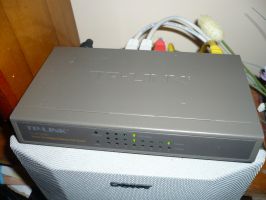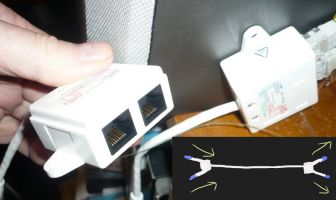Main > Technology > Computers > Networks > Networks & connections > Wireless networks
Location: Place wireless router in a central location in your home.
[guest]
|
|
|
Main > Technology > Computers > Networks > Networks & connections > Wireless networks
Directional antennas: Use of a directional antenna, rather than the standard omni-directional one, will make the signal stronger in one direction.
[guest]
|
|
|
Main > Technology > Computers > Networks > Networks & connections > Wireless networks
Extending the range: Use a wireless repeater to extend the range of your network. The brand of the repeater may need to match the router for best performance. And when using a repeater, you can expect reduced throughput speeds.
[guest]
|
|
|
Main > Technology > Computers > Networks > Networks & connections > Wireless networks
Matching brands of hardware: If the brand of your router matches that of your network adapters, you may get better performance.
[guest]
|
|
|
Main > Technology > Computers > Networks > Networks & connections > Wireless networks
Trying different channels: You can try changing your wireless router's channel through your router's configuration page to see if your signal strength improves.
[guest]
|
|
|
Main > Technology > Computers > Networks > Networks & connections > Wireless networks
Avoid interference: To quiet the noise, avoid wireless electronics that use the 2.4GHz frequency. Instead, look for cordless phones that use the 5.8GHz or 900MHz frequencies.
[guest]
|
|
|
Main > Technology > Computers > Networks > Networks & connections > Wireless networks > Security
Usernames and passwords: change the default administrator passwords and usernames for the access point or router. The defaults are well known to hackers on the Internet. Manufacturers provide Web pages that allow owners to enter their network address and account information.
[guest]
|
|
|
Main > Technology > Computers > Networks > Networks & connections > Wireless networks > Security
Encryption: turn on encryption. All Wi-Fi devices on your network must share identical encryption settings.
[guest]
|
|
|
Main > Technology > Computers > Networks > Networks & connections > Wireless networks > Security
SSID: change the default SSID. Access points and routers all use a network name called the SSID. Manufacturers normally ship their products with the same SSID set.
[guest]
|
|
|
Main > Technology > Computers > Networks > Networks & connections > Wireless networks > Security
Enable MAC Address Filtering: Each piece of Wi-Fi gear possesses a unique identifier called the physical address or MAC address. Access points and routers keep track of the MAC addresses of all devices that connect to them. Many such products offer the owner an option to key in the MAC addresses of their home equipment, that restricts the network to only allow connections from those devices.
[guest]
|
|
|
Main > Technology > Computers > Networks > Networks & connections > Wireless networks > Security
Disable SSID Broadcast: the wireless access point or router typically broadcasts the network name (SSID) over the air at regular intervals. This feature was designed for businesses and mobile hotspots where Wi-Fi clients may roam in and out of range. In the home this roaming feature is unnecessary, and it increases the likelihood someone will try to log in to your home network.
[guest]
|
|
|
Main > Technology > Computers > Networks > Networks & connections > Wireless networks > Security
Don't auto-Connect to Open Wi-Fi Networks: connecting to an open Wi-Fi network such as a free wireless hotspot or your neighbor's router exposes your computer to security risks. Although not normally enabled, most computers have a setting available allowing these connections to happen automatically without notifying you (the user). This setting should not be enabled except in temporary situations.
[guest]
|
|
|
Main > Technology > Computers > Networks > Networks & connections > Wireless networks > Security
Assign Static IP Addresses to Devices: Most home networkers gravitate toward using dynamic IP addresses. DHCP technology is indeed easy to set up. Unfortunately, this convenience also works to the advantage of network attackers, who can easily obtain valid IP addresses from your network's DHCP pool. Turn off DHCP on the router or access point, set a fixed IP address range instead, then configure each connected device to match. Use a private IP address range (like 10.0.0.x) to prevent computers from being directly reached from the Internet.
[guest]
|
|
|
Main > Technology > Computers > Networks > Networks & connections > Wireless networks > Security
Firewalls: Ensure that your router's firewall is turned on. For extra protection, consider installing and running personal firewall software on each computer connected to the router.
[guest]
|
|
|
Main > Technology > Computers > Networks > Networks & connections > Wireless networks > Security
Location of access point or router: if you place this device centrally, the extent of the signal being broadcast outside your home will not reach so far as it would otherwise.
[guest]
|
|
|
Main > Technology > Computers > Networks > Networks & connections > Wireless networks > Security
Turn off the network: if not using it for extended periods of time.
[guest]
|
|
|
Main > Technology > Computers > Networks > Networks & connections > Wireless networks
Update your firmware or your network adapter driver: Router manufacturers regularly make free improvements to their routers. Sometimes, these improvements increase performance. To get the latest firmware updates for your router, visit your router manufacturer's Web site. Similarly, network adapter vendors occasionally update the software that Windows XP uses to communicate with your network adapter, known as the driver.
[guest]
|
|
|
Main > Technology > Computers > Networks > Networks & connections > Wireless networks
Modem: If you want the router to be connected to the Internet even when all your computers are turned off, your broadband modem will need to have a network/ethernet socket. Some USB modems do not have a network/ethernet socket.
[guest]
|
|
|
Main > Technology > Computers > Networks > Networks & connections > Wireless networks
Modem and router in one: If you don't already own a modem, it is simpler and cheaper to get a wireless router with a built-in modem.
[guest]
|
|
|
Main > Technology > Computers > Networks > Networks & connections > Wired networks
Supply power over an ethernet cable using POE ("power over ethernet") technology. This is ideal for providing power to security cameras which may not be near a power source. This can be done with a POE switch (pictured), or a POE injector. If the camera or device does not support POE then an active POE splitter is required at the destination end of the cable to separate the data from the power, and to reduce the voltage to an appropriate level for the device.
thesource (378)

Click to enlarge
|
|
|
Main > Technology > Computers > Networks > Networks & connections > Wired networks
Run TWO ethernet signals over a single ethernet cable by using splitters (pictured). This can be preferable to running an extra cable, however this is only possible when you are not using Gigabit ethernet speeds. Slower speeds, such as 100Mbps, which is fast enough for most purposes, use only four of the eight wires in the cable. Splitters divide the cable into two lots of four, enabling you to use all eight wires for two separate ethernet signals. You will need a splitter on each end of the cable.
thesource (378)

Click to enlarge
|
|
|
